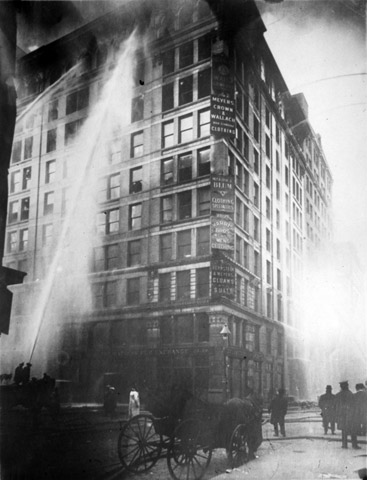JMM Insights: The Triangle Shirtwaist Factory Fire


Today’s JMM Insights comes to us from Mark Gunnery, Director of Communications and Content for the JMM.
Last week, our new exhibit, Blacklist: The Hollywood Red Scare, opened to the public. Throughout the run of the exhibit, we here at the JMM are highlighting the different moments in history that connect to Blacklist’s themes, including labor and immigrant rights organizing, political repression, and Jewish radical politics.
Today marks 111 years since the Triangle Shirtwaist Factory fire. The 1911 fire in Manhattan was one of the deadliest industrial disasters in US history, killing 146 garment workers, mostly Jewish and Italian immigrant women and girls.
We invite you to honor the memory of the people who died in the Triangle Shirtwaist Factory and reflect on the lasting impact the fire had on the world.
The Triangle Shirtwaist Factory fire erupted on March 25, 1911, and was likely started by a lit match accidentally falling into a bin of fabric scraps. The fire spread quickly, but most of the employees could not escape because they were locked in by management. Locked doors were common in sweatshops at the time as means of preventing workers from taking unauthorized breaks, stealing materials or engaging in wildcat strikes. Many workers died trapped inside the factory or by leaping out the windows to escape the smoke and flames.
In the wake of the fire and the waves of protest that it sparked, the state of New York investigated working conditions in factories. New York eventually passed new legislation improving safety measures in factories and protecting women and children in the workplace.
The owners of the factory, Isaac Harris and Max Blank, were put on trial and acquitted. They collected insurance and soon reopened their shop at a new address.

The fire came less than two years after the Uprising of the 20,000, when thousands of workers in the needle trades, mostly Yiddish-speaking immigrant women and girls in their teens and twenties, rose up in protest of their working conditions. The uprising started with spontaneous strikes at companies that made shirtwaists, blouses for women that were in style at the time, before cohering into an industry-wide eleven week strike.

One of the leaders and instigators of the strike was Clara Lemlich Shavelson. Born in Gorodok, Ukraine, she was a committed teenage revolutionary when she immigrated to the US. She worked in a Lower East Side garment shop, and started organizing other women in her shop into the International Ladies Garment Workers Union. After the Uprising of the 20,000, she was blacklisted from New York garment shops. Shavelson never stopped fighting for justice, even in her final years, when she helped the orderlies at the Jewish Home for the Aged in Los Angeles, where she lived, in their union organizing drive.
